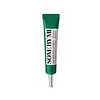What's inside
What's inside
 Key Ingredients
Key Ingredients

 Benefits
Benefits

 Concerns
Concerns

 Ingredients Side-by-side
Ingredients Side-by-side

Melaleuca Alternifolia Leaf Water
AntimicrobialCentella Asiatica Extract
CleansingGlycerin
HumectantWater
Skin ConditioningButylene Glycol
HumectantNiacinamide
SmoothingPanthenol
Skin ConditioningArtemisia Princeps Leaf Extract
Skin ConditioningLavandula Angustifolia Extract
Skin ConditioningRosmarinus Officinalis Extract
AntimicrobialOriganum Vulgare Flower/Leaf/Stem Extract
Skin ConditioningThymus Vulgaris Extract
PerfumingSodium Hyaluronate
HumectantSaccharide Isomerate
HumectantFructan
Skin ConditioningSalicylic Acid
MaskingMadecassoside
AntioxidantMadecassic Acid
Skin ConditioningAsiaticoside
AntioxidantAsiatic Acid
Skin ConditioningAllantoin
Skin ConditioningProtease
ExfoliatingLipase
Skin ConditioningAdenosine
Skin ConditioningLactobionic Acid
BufferingCitric Acid
BufferingSorbitan Oleate
EmulsifyingCaprylyl/Capryl Glucoside
CleansingPolyisobutene
Microcrystalline Cellulose
AbsorbentCellulose Gum
Emulsion StabilisingGlyceryl Acrylate/Acrylic Acid Copolymer
HumectantMagnesium Aluminum Silicate
AbsorbentSodium Acrylate/Sodium Acryloyldimethyl Taurate Copolymer
Emulsion StabilisingAmmonium Acryloyldimethyltaurate/Vp Copolymer
1,2-Hexanediol
Skin ConditioningBenzyl Glycol
SolventEthylhexylglycerin
Skin ConditioningRaspberry Ketone
MaskingDisodium EDTA
Mentha Piperita Oil
MaskingMelaleuca Alternifolia Leaf Water, Centella Asiatica Extract, Glycerin, Water, Butylene Glycol, Niacinamide, Panthenol, Artemisia Princeps Leaf Extract, Lavandula Angustifolia Extract, Rosmarinus Officinalis Extract, Origanum Vulgare Flower/Leaf/Stem Extract, Thymus Vulgaris Extract, Sodium Hyaluronate, Saccharide Isomerate, Fructan, Salicylic Acid, Madecassoside, Madecassic Acid, Asiaticoside, Asiatic Acid, Allantoin, Protease, Lipase, Adenosine, Lactobionic Acid, Citric Acid, Sorbitan Oleate, Caprylyl/Capryl Glucoside, Polyisobutene, Microcrystalline Cellulose, Cellulose Gum, Glyceryl Acrylate/Acrylic Acid Copolymer, Magnesium Aluminum Silicate, Sodium Acrylate/Sodium Acryloyldimethyl Taurate Copolymer, Ammonium Acryloyldimethyltaurate/Vp Copolymer, 1,2-Hexanediol, Benzyl Glycol, Ethylhexylglycerin, Raspberry Ketone, Disodium EDTA, Mentha Piperita Oil
Water
Skin ConditioningBentonite
AbsorbentGlycerin
HumectantCalamine
AbsorbentPropanediol
SolventAluminum Silicate
AbrasiveSilicon
AbrasivePotassium Azeloyl Diglycinate
Skin ConditioningSulfur
AntiseborrhoeicZinc Oxide
Cosmetic ColorantPEG-8
HumectantPolyacrylamide
Gluconolactone
Skin ConditioningZinc PCA
HumectantBackhousia Citriodora Leaf Extract
AstringentOlea Europaea Fruit Oil
MaskingCarthamus Tinctorius Seed Oil
MaskingPapain
Skin ConditioningBromelain
Skin ConditioningXanthan Gum
EmulsifyingC13-14 Isoparaffin
EmollientSalicylic Acid
MaskingC9-11 Pareth-6
EmulsifyingTrisodium Ethylenediamine Disuccinate
Isostearamidopropyl Ethyldimonium Ethosulfate
Sodium Hydroxide
BufferingTriethoxycaprylylsilane
Propylene Glycol
HumectantPhenoxyethanol
PreservativeEthylhexylglycerin
Skin ConditioningCitric Acid
BufferingWater, Bentonite, Glycerin, Calamine, Propanediol, Aluminum Silicate, Silicon, Potassium Azeloyl Diglycinate, Sulfur, Zinc Oxide, PEG-8, Polyacrylamide, Gluconolactone, Zinc PCA, Backhousia Citriodora Leaf Extract, Olea Europaea Fruit Oil, Carthamus Tinctorius Seed Oil, Papain, Bromelain, Xanthan Gum, C13-14 Isoparaffin, Salicylic Acid, C9-11 Pareth-6, Trisodium Ethylenediamine Disuccinate, Isostearamidopropyl Ethyldimonium Ethosulfate, Sodium Hydroxide, Triethoxycaprylylsilane, Propylene Glycol, Phenoxyethanol, Ethylhexylglycerin, Citric Acid
 Reviews
Reviews

Ingredients Explained
These ingredients are found in both products.
Ingredients higher up in an ingredient list are typically present in a larger amount.
Citric Acid is an alpha hydroxy acid (AHA) naturally found in citrus fruits like oranges, lemons, and limes.
Like other AHAs, citric acid can exfoliate skin by breaking down the bonds that hold dead skin cells together. This helps reveal smoother and brighter skin underneath.
However, this exfoliating effect only happens at high concentrations (20%) which can be hard to find in cosmetic products.
Due to this, citric acid is usually included in small amounts as a pH adjuster. This helps keep products slightly more acidic and compatible with skin's natural pH.
In skincare formulas, citric acid can:
While it can provide some skin benefits, research shows lactic acid and glycolic acid are generally more effective and less irritating exfoliants.
Most citric acid used in skincare today is made by fermenting sugars (usually from molasses). This synthetic version is identical to the natural citrus form but easier to stabilize and use in formulations.
Read more about some other popular AHA's here:
Learn more about Citric AcidEthylhexylglycerin (we can't pronounce this either) is commonly used as a preservative and skin softener. It is derived from glyceryl.
You might see Ethylhexylglycerin often paired with other preservatives such as phenoxyethanol. Ethylhexylglycerin has been found to increase the effectiveness of these other preservatives.
Glycerin is already naturally found in your skin. It helps moisturize and protect your skin.
A study from 2016 found glycerin to be more effective as a humectant than AHAs and hyaluronic acid.
As a humectant, it helps the skin stay hydrated by pulling moisture to your skin. The low molecular weight of glycerin allows it to pull moisture into the deeper layers of your skin.
Hydrated skin improves your skin barrier; Your skin barrier helps protect against irritants and bacteria.
Glycerin has also been found to have antimicrobial and antiviral properties. Due to these properties, glycerin is often used in wound and burn treatments.
In cosmetics, glycerin is usually derived from plants such as soybean or palm. However, it can also be sourced from animals, such as tallow or animal fat.
This ingredient is organic, colorless, odorless, and non-toxic.
Glycerin is the name for this ingredient in American English. British English uses Glycerol/Glycerine.
Learn more about GlycerinSalicylic Acid (also known as beta hydroxy acid or BHA) is a well-known ingredient for treating skin that struggles with acne and clogged pores. It exfoliates both the skin's surface and deep within the pores to help clear out buildup, control oil, and reduce inflammation.
Unlike AHAs (alpha hydroxy acids), salicylic acid is oil-soluble. This allows it to penetrate into pores which makes it especially effective for treating blackheads and preventing future breakouts.
Salicylic acid is also known for its soothing properties. It has a similar structure to aspirin and can calm inflamed or irritated skin, making it a good option for acne-prone skin that is also sensitive.
Concentrations of 0.5-2% are recognized by the U.S. FDA as an over-the-counter topical acne product.
It can cause irritation and/or dryness if one's skin already has a compromised moisture barrier, so it's best to focus on repairing that before introducing this ingredient into your routine.
While salicylic acid does not increase sun sensitivity, it’s still important to wear sunscreen daily to protect your skin.
If you are looking for the ingredient called BHA or Butylated Hydroxyanisole, click here.
Learn more about Salicylic AcidWater. It's the most common cosmetic ingredient of all. You'll usually see it at the top of ingredient lists, meaning that it makes up the largest part of the product.
So why is it so popular? Water most often acts as a solvent - this means that it helps dissolve other ingredients into the formulation.
You'll also recognize water as that liquid we all need to stay alive. If you see this, drink a glass of water. Stay hydrated!
Learn more about Water